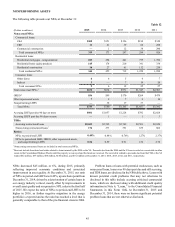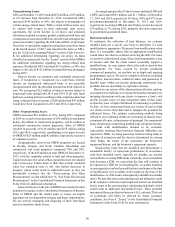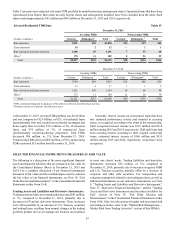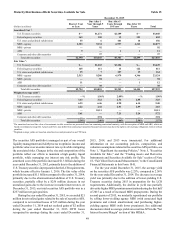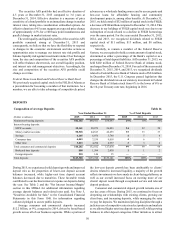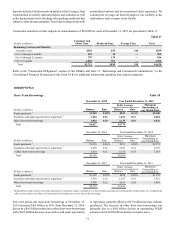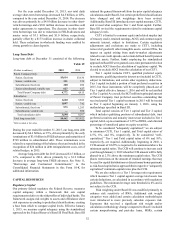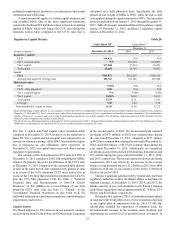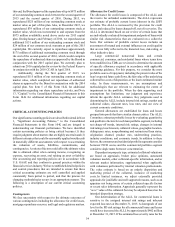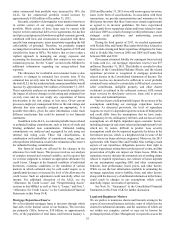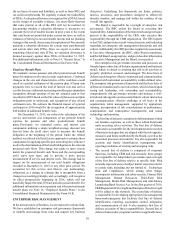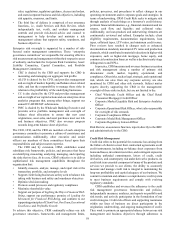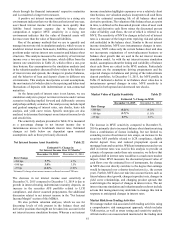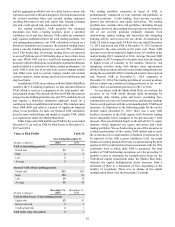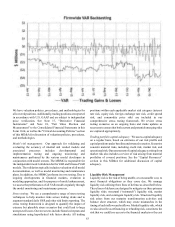SunTrust 2015 Annual Report Download - page 82
Download and view the complete annual report
Please find page 82 of the 2015 SunTrust annual report below. You can navigate through the pages in the report by either clicking on the pages listed below, or by using the keyword search tool below to find specific information within the annual report.54
this end, the Board approved the repurchase of up to $875 million
of our outstanding common stock between the second quarter of
2015 and the second quarter of 2016. During 2015, we
repurchased $525 million of our outstanding common stock at
market value as part of this plan. Also, in December 2015, we
repurchased $39 million of our outstanding common stock at
market value, which was incremental to and separate from the
$875 million availability noted above under our 2015 capital
plan. During January and February of 2016, we repurchased an
additional $151 million of our outstanding common stock and
$24 million of our common stock warrants as part of this 2015
capital plan. We currently expect to repurchase approximately
$175 million of additional outstanding common stock through
the end of the second quarter of 2016, which would complete
the repurchase of authorized shares as approved by the Board in
conjunction with the 2015 capital plan. We currently plan to
submit our 2016 capital plan for review by the Federal Reserve
in conjunction with the 2016 CCAR in April 2016.
Additionally, during the first quarter of 2015, we
repurchased $115 million of our outstanding common stock at
market value, which completed our repurchase of authorized
shares as approved by the Board in conjunction with the 2014
capital plan. See Item 5 of this Form 10-K for additional
information regarding our share repurchase activity, and Note
13, "Capital," to the Consolidated Financial Statements in this
Form 10-K for additional information regarding our capital
actions.
CRITICAL ACCOUNTING POLICIES
Our significant accounting policies are described in detail in Note
1, “Significant Accounting Policies,” to the Consolidated
Financial Statements in this Form 10-K and are integral to
understanding our financial performance. We have identified
certain accounting policies as being critical because (1) they
require judgment about matters that are highly uncertain and (2)
different estimates that could be reasonably applied would result
in materially different assessments with respect to ascertaining
the valuation of assets, liabilities, commitments, and
contingencies. A variety of factors could affect the ultimate value
that is obtained either when earning income, recognizing an
expense, recovering an asset, and valuing an asset or liability.
Our accounting and reporting policies are in accordance with
U.S. GAAP, and they conform to general practices within the
financial services industry. We have established detailed policies
and control procedures that are intended to ensure that these
critical accounting estimates are well controlled and applied
consistently from period to period, and that the process for
changing methodologies occurs in an appropriate manner. The
following is a description of our current critical accounting
policies.
Contingencies
We face uncertainty with respect to the ultimate outcomes of
various contingencies including the allowance for credit losses,
mortgage repurchase reserves, and legal and regulatory matters.
Allowance for Credit Losses
The allowance for credit losses is composed of the ALLL and
the reserve for unfunded commitments. The ALLL represents
our estimate of probable current losses inherent in the LHFI
portfolio. The ALLL is increased by the provision for credit
losses and reduced by loans charged-off, net of recoveries. The
ALLL is determined based on our review of certain loans that
are individually evaluated for impairment and pools of loans with
similar risk characteristics that are evaluated on a collective
basis. Our estimate of probable current losses includes an
assessment of internal and external influences on credit quality
that are not fully reflected in the historical loss, risk-rating, or
other indicative data.
Large commercial nonaccrual loans and certain
commercial, consumer, and residential loans whose terms have
been modified in a TDR, are reviewed to determine the amount
of specific allowance required in accordance with applicable
accounting guidance. For this purpose, we consider the most
probable source of repayment, including the present value of the
loan's expected future cash flows, the fair value of the underlying
collateral less costs of disposition, or the loan's estimated market
value. In these measurements, we use assumptions and
methodologies that are relevant to estimating the extent of
impairment in the portfolio. When the data supporting such
assumptions has limitations, our judgment and experience
inform the specific ALLL estimates. Key judgments used in
determining the ALLL include internal risk ratings, market and
collateral values, discount rates, loss rates, and our view of
current economic conditions.
General allowances are established for loans and leases
grouped into pools that have similar characteristics. The ALLL
Committee estimates probable losses by evaluating quantitative
and qualitative factors for each loan portfolio segment, including
net charge-off trends, internal risk ratings, changes in internal
risk ratings, loss forecasts, collateral values, geographic location,
delinquency rates, nonperforming and restructured loan status,
origination channel, product mix, underwriting practices,
industry conditions, and economic trends. In addition to these
factors, the consumer and residential portfolio segments consider
borrower FICO scores and the commercial portfolio segment
considers single name borrower concentration.
Dependent on property type, estimated collateral valuations
are based on appraisals, broker price opinions, automated
valuation models, other collateral-specific information, and/or
relevant market information, supplemented when applicable
with valuations performed by internal valuation professionals.
The value estimate is based on an orderly disposition and
marketing period of the collateral, inclusive of marketing
costs. In limited instances, we adjust externally provided
appraisals for justifiable and well supported reasons, such as an
appraiser not being aware of certain collateral-specific factors
or recent sales information. Appraisals generally represent the
“as is” value of the collateral but may be adjusted based on the
intended disposition strategy.
Our determination of the ALLL for commercial loans is
sensitive to the assigned internal risk ratings and inherent
expected loss rates at December 31, 2015. A downgrade of one
level in the PD risk ratings for all commercial loans and leases
would have increased the ALLL by approximately $402 million
at December 31, 2015. If the estimated loss severity rates for the



